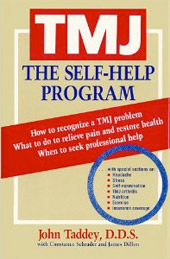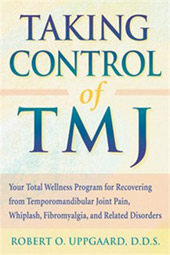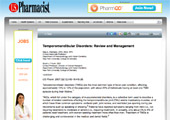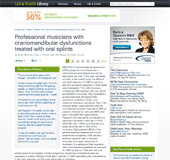|
A Layman’s Guide To ICBC Part 7 Benefits
Download the article |
|
Lips Together Teeth Apart
One of the most important steps in breaking the habit of clenching and grinding your teeth is to become conscious of when it occurs and, of course, to stop doing it.
An excellent way to avoid clenching is to learn to keep your lips together and your teeth apart. This simple step will not only make it impossible to clench your teeth, but more importantly, it will allow your tense jaw and facial muscles to relax. It also permits more normal positioning of the components of your jaw joints….
Download the article |
|
Appliance Care
Download the article |
 |
The TMJ Self-Help Program
by Dr. John Taddey
TMJ: The Self-Help Program is a comprehensive guide written by a doctor specializing in the treatment of temporomandibular disorders—TMJ. These common disorders, affecting millions of people, are a group of painful and functional conditions that have their origin in the jaw joint and the jaw and neck muscles. Dr. Taddey explains how to pinpoint the source of your problem, then describes what you can do on your own to minimize any trouble.
Whether you’ve only recently developed symptoms of TMJ or have suffered for years with pain and discomfort, there is help available. Take your first step to relief now.
|
 |
Taking Control of TMJ
by Robert O Uppgaard
Taking Control of TMJ: Your Total Wellness Program for Recovering from Temporomandibular Joint Pain, Whiplash, Fibromyalgia, and Related Disorders.
If you are among the 60 million people in the United States affected by TMJ disorder, then you may know what it’s like to have your problem be misdiagnosed or go untreated. Perhaps you’ve undergone unnecessary and costly treatments to no avail. Dr. Uppgaard’s Total Wellness Program will help you understand this painful condition, relieve its symptoms, prevent its recurrence, and avoid unnecessary surgery. This comprehensive guide also explores the connection TMJ disorder has to fibromyalgia and whiplash.
|
 |
Temporomandibular Disorders: Review and Management
by Weinberg and Froum (link also on Doctor Education page)
Temporomandibular disorders (TMDs) are the most common type of facial pain condition, affecting approximately 10% to 12% of the population, with about 25% of individuals having at least one TMD episode during their lifetime.
TMDs, which fall under the category of musculoskeletal disorders, is a collective term used to describe a number of related conditions affecting the temporomandibular joint (TMJ) and/or masticatory muscles, all of which have three common symptoms: orofacial pain, joint noises, and restricted jaw opening during jaw movements such as speaking or chewing.2Patients have reported symptoms ranging from mild (i.e., not requiring treatment) to moderate or severe (i.e., requiring treatment). In actuality, only about 5% to 6% of patients need treatment, with women seeking treatment more often than men. Treatment of TMDs is challenging and controversial in the medical and dental fields.
Go to the article |
 |
Professional Musicians with Craniomandibular Dysfunction Treated with Oral Splints
It is now recognized that professional and skilled amateur musicians require complex coordinated movements in order to perform and that musculoskeletal problems frequently arise as a result. At ORC we work with the performer to support the management of associated pain and problems in the neck , shoulder and upper extremities. Article by Stienmetz A et al: . Cranio Journal , Oct. 2009 221- 230.
Go to the article |






